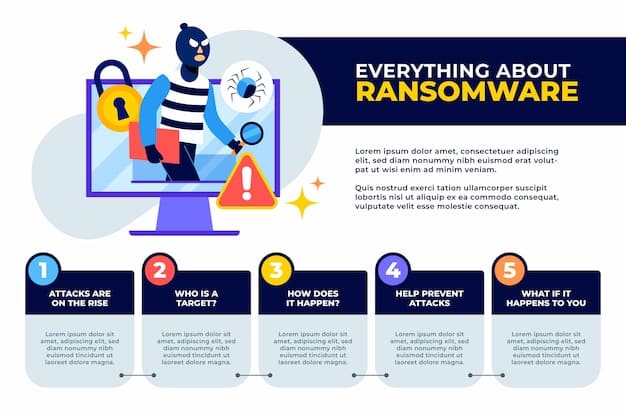Data Breach Costs Soaring: Cut Your Company’s Risk by 20%

Data breach costs are escalating, but understanding the key factors driving these expenses and implementing proactive cybersecurity measures can significantly reduce your company’s risk by up to 20%.
The increasing frequency and sophistication of cyberattacks have led to an alarming surge in data breach costs soaring. Businesses must proactively address vulnerabilities to reduce their company’s risk by 20%.
Understanding the Escalating Costs of Data Breaches
Data breaches are becoming increasingly expensive, impacting organizations of all sizes. Understanding the multifaceted nature of these costs is the first step in implementing effective risk reduction strategies.
The financial repercussions extend beyond immediate recovery efforts. There are long-term impacts that can severely damage a company’s reputation.
Direct and Indirect Costs Explained
A data breach incurs both direct and indirect expenses. Direct costs are easily quantifiable, while indirect costs are more challenging to assess yet equally significant.
- Direct Costs: Include expenses such as forensic investigations, legal fees, notification costs to affected parties, and regulatory fines.
- Indirect Costs: Encompass lost business, reputational damage, customer churn, and decreased employee productivity.
- Hidden Costs: Refer to long-term monitoring services for affected individuals, investments in improved security infrastructure, and employee training programs.
Comprehensive knowledge of both direct and indirect costs is crucial to determine the total financial impact of a data breach.
Key Factors Driving Data Breach Expenses
Several elements are contributing to the escalating costs of data breaches. Pinpointing these factors allows businesses to tailor their mitigation strategies effectively.
Understanding trends in the evolving threat landscape helps organizations anticipate future risks and prepare accordingly.

Human Error, Malware, and Phishing
These are the primary causes of many data breaches. Addressing these vulnerabilities can provide substantial improvements in cybersecurity posture.
- Human Error: Includes unintentional disclosure of sensitive information, weak passwords, and failure to follow security protocols.
- Malware: Involves the deployment of malicious software such as ransomware, trojans, and viruses to steal data or disrupt systems.
- Phishing: Uses deceptive emails, messages, or websites to trick individuals into revealing credentials or sensitive data.
Each of these factors requires targeted mitigation strategies to significantly reduce the risk of successful data breaches.
Implementing Robust Cybersecurity Measures to Reduce Risk
Implementing a comprehensive cybersecurity strategy can significantly reduce a company’s vulnerability to data breaches. A layered approach provides the best defense.
Consistent monitoring and proactive threat detection are crucial components of an effective security program.
Endpoint Protection and Network Security
Securing endpoints and networks forms the backbone of a robust cybersecurity defense. These steps help prevent breaches before they occur.
- Endpoint Protection: Involves deploying antivirus software, endpoint detection and response (EDR) systems, and firewalls on all devices.
- Network Security: Includes implementing intrusion detection systems (IDS), intrusion prevention systems (IPS), and virtual private networks (VPNs) to secure network traffic.
- Regular Updates: Ensures all software and security tools are up-to-date with the latest patches and security features.
Taken together, these measures help to safeguard sensitive data and reduce the potential impact of cyberattacks.
Employee Training and Awareness Programs
Employee training and awareness represent a critical layer in any data breach prevention strategy. A well-informed workforce is a powerful defense.
Regular training can help employees recognize and avoid common threats such as phishing scams.
Simulated Phishing Attacks and Security Protocols
These practices can help employees identify and avoid threats. Implementing security policies and protocols is crucial.
Security awareness programs should communicate security policies and protocols clearly and concisely.
Best Practices for Employee Cybersecurity Training
Effective employee training is a cornerstone of a strong cybersecurity posture. The following best practices should be incorporated to maximize results:
- Regular Sessions: Conduct regular training sessions to keep employees informed about the latest threats and vulnerabilities.
- Interactive Content: Use interactive content such as quizzes, simulations, and real-world examples to engage employees and reinforce learning.
- Policy Reinforcement: Regularly reinforce security policies and best practices through reminders and updates.
Integrating these best practices into employee training programs can significantly enhance an organization’s overall cybersecurity defense.

Developing and Testing an Incident Response Plan
Having a well-defined incident response plan is essential for minimizing the damage from a data breach. A fast and coordinated response minimizes financial impact.
Regular testing and updates to the incident response plan are critical to ensure its effectiveness.
Key Components of an Incident Response Plan
An incident response plan should outline the steps to be taken in the event of a data breach. The plan’s components are crucial for an efficient response.
- Identification: Quickly identify the scope and nature of the data breach.
- Containment: Isolate affected systems to prevent further data loss.
- Eradication: Eliminate the root cause of the breach.
- Recovery: Restore affected systems and data.
- Lessons Learned: Identify areas for improvement and update security measures accordingly.
Each component plays a critical role in mitigating the immediate and long-term impacts of a security breach.
Insurance and Risk Transfer Strategies
Investing in cyber insurance and employing risk transfer strategies can provide financial protection in the event of a data breach. These options can help mitigate substantial losses.
Selecting the right cyber insurance coverage is crucial to ensure comprehensive protection.
Cyber Insurance Coverage and Benefits
Cyber insurance policies can cover a range of expenses associated with data breaches. A well-structured policy offers multifaceted protection.
- Coverage: Policies may cover legal fees, notification costs, forensic investigations, and business interruption losses.
- Benefits: Cyber insurance can also provide access to incident response experts, legal counsel, and public relations support.
- Risk Transfer: Shifting some of the financial burden associated with data breaches to an insurance provider.
Careful consideration of coverage options and policy terms is essential for maximizing the benefits of cyber insurance.
Continuous Monitoring and Improvement
Cybersecurity is an ongoing process that requires continuous monitoring and improvement. This process helps to adapt to evolving threats and maintain a strong security posture.
Regularly assessing and updating security measures ensures that they remain effective.
Tools and Technologies for Monitoring and Analysis
Several tools and technologies can assist in monitoring and analyzing security threats. These tools provide real-time insights and proactive protection.
- SIEM Systems: Security Information and Event Management (SIEM) systems collect and analyze security data from various sources to detect potential threats.
- Threat Intelligence Feeds: These feeds provide up-to-date information about emerging threats and vulnerabilities.
- Vulnerability Scanning: Regular vulnerability scanning can identify weaknesses in systems and applications before they are exploited.
By leveraging these tools and technologies, organizations can improve their ability to detect and respond to cyberattacks effectively.
| Key Area | Brief Description |
|---|---|
| 🛡️ Cybersecurity Measures | Implement robust cybersecurity to protect against escalating data breach costs soaring. |
| 🧑🏫 Employee Training | Enhance awareness through regular training to avoid phishing and human errors. |
| 🚨 Incident Response | Create and regularly test an incident response plan for rapid breach containment. |
| 💸 Cyber Insurance | Secure cyber insurance to cover breach-related costs and transfer financial risk. |
FAQ
▼
Data breach costs include incident response, notification expenses, legal and regulatory fines, and loss of customer trust, impacting brand reputation significantly.
▼
Employee training educates staff about phishing scams and security protocols, making them a critical defense against cyber threats.
▼
It’s a structured approach to handle data breaches, vital for minimizing damage by outlining steps for identification, containment, eradication, and recovery.
▼
Cyber insurance covers expenses such as legal fees, notifications, and forensic investigation, thus mitigating financial impact from a data breach situation.
▼
Companies should continuously update security measures to adapt to emerging threats, conduct frequent risk assessments, and maintain regulatory compliance seamlessly.
Conclusion
Addressing the soaring costs of data breaches requires a comprehensive and proactive approach. By understanding the key factors driving these costs and implementing robust cybersecurity measures, employee training, incident response plans, and insurance strategies, businesses can significantly reduce their company’s risk and protect their valuable assets.





